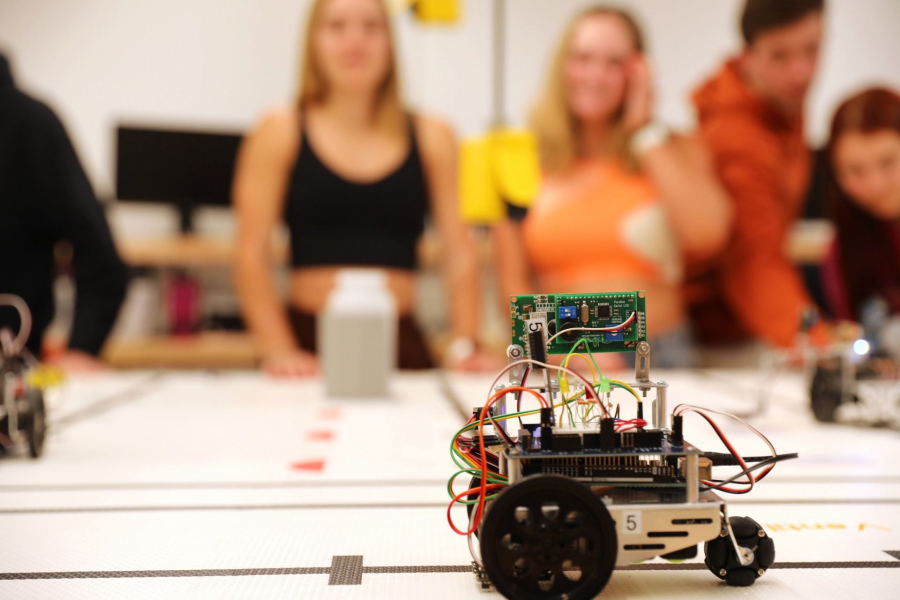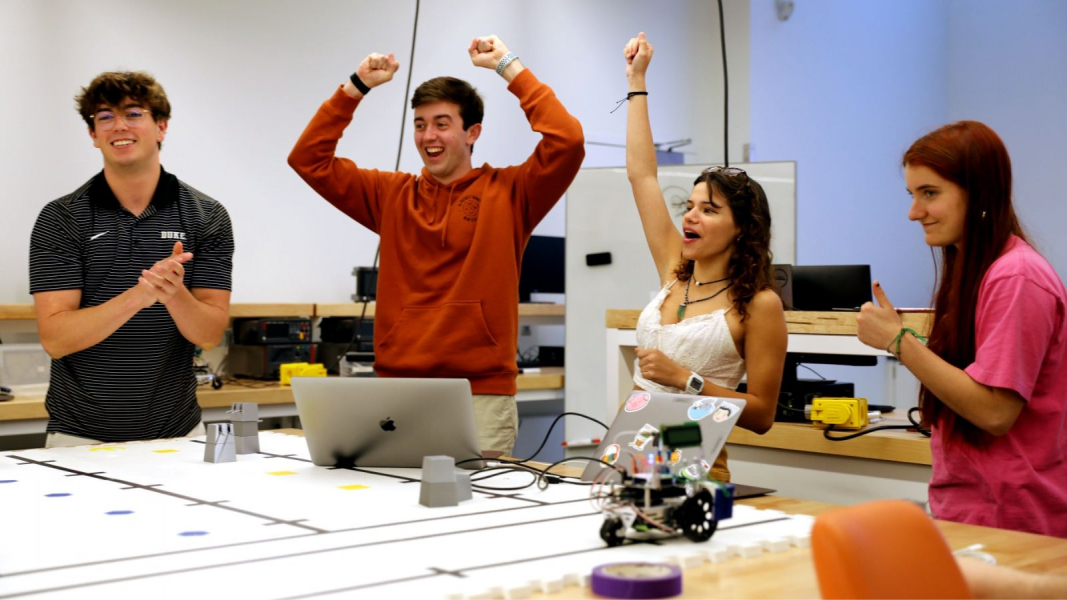Integrated Design Challenge in Duke ECE Restores Balance to The Force
Miranda Volborth
On a Star Wars-themed field of play, student teams deployed small robots they had constructed

“That’s no moon.”
The aging R-2 units that guide the Rebel Alliance’s X-wing starfighters are ready to be retired. They’ll be replaced with shiny new CX-B droids built and programmed by an elite team of Duke’s ECE 110L engineers. Once installed, the new droids will work together to intercept pieces of code broadcast by the Imperial fleet and use the code to coordinate an attack on the Empire’s hulking battle station.
The fate of the galaxy now rests in the hands of Duke Engineering students.
 This Death Star is, of course, a theoretical concept represented by a 3D-printed model the size of a baseball. The ventilation shaft through which the starships will attack is marked in black tape. But the intensity with which the students approach the challenge could rival Luke Skywalker’s.
This Death Star is, of course, a theoretical concept represented by a 3D-printed model the size of a baseball. The ventilation shaft through which the starships will attack is marked in black tape. But the intensity with which the students approach the challenge could rival Luke Skywalker’s.
“After nearly two decades of teaching, I’ve found that the best way to connect with and engage a student is to connect their learning to something they likely enjoy,” said Adam Davidson, the lab administrator for electrical and computer engineering. “It helps to provide something topical and, if possible, relevant to pop culture—right now, Star Wars is both of those.”
ECE 110L is a foundational course for students majoring in electrical and computer engineering, and it’s required for biomedical engineering students as well. That’s because the core concepts covered in this lab—sensor data acquisition and processing—provide a foundation of knowledge and skills upon which every subsequent course will build.
Central to the course is the “integrated design challenge,” or IDC, which is the framework that helps sequence and structure all the topics that students will master over the course of the semester: using servos with QTI sensors to navigate dark paths against light backgrounds and RGB color sensors to differentiate among colored objects, displaying data on LCD screens, and transmitting and receiving information via wireless XBee devices.
From year to year, the theme of the IDC changes. Other recent challenges have hinged on themes as varied as Harry Potter’s Quidditch and the Olympic Games. Teaching assistant Michaela Harris, a student studying ECE and BME, took the class last semester when the theme was “Mission to Mars.”

“My own semester started out rough because I had no experience with the programming language that we use, so I had a hard time completing some of the checkpoints,” said Harris. “I put in some time outside of class to learn a little more about C/C++ and learned the syntax of the language, which helped me enjoy lab more as the semester progressed.”
Harris said she feels lucky that she had a fun lab with great teaching assistants who helped keep the stress level down. She said she became a TA herself to “pay that experience forward.” Because of her own initial difficulty understanding the C/C++, Harris created slides for her section that introduced them to the programming language and gave examples to refer to in the early labs—which she noticed they frequently did.
“They also worked super hard to get through this challenge—they talked to each other, consulted the internet a bunch and asked super awesome questions when they were stuck,” said Harris.

One issue that she didn’t foresee, though, was prevailing problems with the bots’ power supply. “The robots had a lot of commands to run for a long period of time and the batteries of their bots drained quickly,” explained Harris.
Despite the fact that a couple of teams were still debugging their code in the minutes before their final runs, it was only the power supply issues that caused problems for Harris’s section— the buggy code proved to have been fixed and those bots completed their tasks flawlessly.

“Power management is a pain, a real pain,” said Davidson. “In STEM education we are often taught at a young age to think outside of the box, and that you have an unlimited budget and all the supplies you want or need. Reality is in stark contrast to this.”
“Our students leave ECE 110L with a higher degree of knowledge about how to deploy microcontrollers, servos, and a smattering of sensors and displays, all of which they’ll continue to have access to and be expected to use in their advanced design courses.”
Adam Davidson | Duke ECE lab manager
It’s great to shoot for the pie-in-the-sky scenario, said Davidson, but students also have to work with changing conditions and constraints—like being handed an older lithium-ion battery. “Students sometimes have to account for conditions on the fly,” said Davidson. “We want our students to develop a mentality of resilience and to learn from a failure, even if that failure may sting a little. In the real world of engineering, this will happen more often than not.”
After the IDC concludes, each student participates in an oral defense. (Or, in this semester’s case, a “final run debrief.”) During the defense, lab administrators and teaching assistants will quiz students on their code and ask questions about the choices they made in their builds. This ensures that they’ve got a solid grasp of the concepts before they move on to more advanced classes.
“After they finish ECE 110L, our students are more prepared to take courses on microelectronic devices and circuits, fields and waves, signals and systems, and a variety of BME courses as well,” said Davidson. “Our students leave ECE 110L with a higher degree of knowledge about how to deploy microcontrollers, servos, and a smattering of sensors and displays, all of which they’ll continue to have access to and be expected to use in their advanced design courses. They’ll be comfortable with standard benchtop equipment, too, like oscilloscopes, waveform generators, digital multimeters and DC power supplies, which they’ll use in courses and labs throughout their time here at Duke.”
